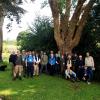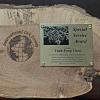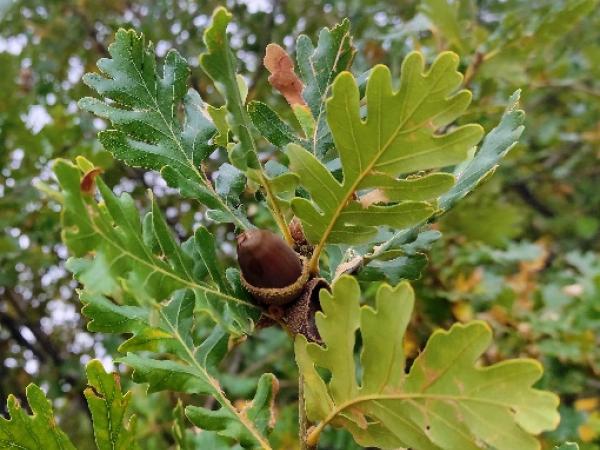Editor's Picks
Plant Focus
Out of around 430 oak species worldwide, some 170 are known to grow in Mexico, and of those 56 grow in the state of Oaxaca. This really is a diverse, rich, and colorful place on the globe. And the 11th IOS Conference was no different. Oak enthusiasts from 20 countries from all over the world and practically all continents gathered in Mexico for the first time since the 6th IOS Conference, which was held in Puebla. Once again, the IOS members met with a joint mission, or, better said, passion for oaks. The Conference was preceded by the seven-day long Pre-Conference Tour starting in Morelia, Michoacán and then through Guanajuato, Puebla, and Veracruz. After having the opportunity to meet dozens of Mexican oaks in the field, the participants arrived in Oaxaca (a report of the Tour will be shared in the next issue of The Cupule).

©John Leszczynski
The main event started at Hotel Victoria, the Conference venue, on Sunday, October 5, with the Satellite Meeting of the Global Conservation Consortium for Oak, during which the Mexico and Central America Species’ Stewards met to share the novel findings and insights related to Mesoamerican oaks. That evening, Conference participants were welcomed by host Antonio González Rodríguez and heard an account of the Satellite Meeting’s achievements from Maricela Rodríguez Acosta, GCCO Coordinator for that region. A Mariachi band then invited us to mingle at a lively Welcome Reception.
Video: Roderick Cameron
The following morning, the Conference began in earnest. After an inspirational address by IOS President Roderick Cameron, it was time to kick off the program of 46 talks on oak stories and another 20 in the form of poster presentations. A total of 140 registered participants attended the event. This number indicates that many people came to hear about oaks and connect with fellow oak enthusiasts, not only to share their own work, proving how vital and engaged the IOS membership really is.

©John Leszczynski
The first two sessions of the Conference were almost entirely dedicated to Mesoamerican oaks, beginning with Susana Valencia Ávalos's excellent Keynote address: "Mexican Oaks: a History of Their Evolution, Importance, and Taxonomic Mystery".

©Roderick Cameron
We learned that this beautiful richness in oaks has its challenges—many endangered and threatened species are found among the oaks of this region. Population genomics and structure, functional ecophysiology, seedlings response, and adaptive potential of Mesoamerican oaks were all important topics presented and it seems that conservation efforts should be locally adapted to suit the needs of the local populations. A dedicated group of scientists from Mexico work on all of these aspects as we have learned from many presentations of the PhD candidates and their supervisors. Yet, a question of capacities and priorities comes up. Are there enough people and resources to cover all the work in this area in the light of rapid climate change? We cannot be sure, but we can be certain that Mexican oak researchers are the true heroes of oak conservation in this area.
Presentations during the Conference were delivered in English and Spanish, and simultaneous translation of the highest quality, into both languages, were provided by World Class Traductores.

©Roderick Cameron (above) John Leszczynski (below)

In the next sessions we learned about the fascinating aspects of the adaptive introgression in oaks and hybridization in the context of phenotypic variation, and we even contemplated the notion of maladaptation in oaks. We delved into lab methods, other oak-related organisms such as herbivory and endophytic fungi, but also taxonomic questions related to cultivar validation issues. This day’s sessions were closed in the best possible way—highlighting the importance of the young generations’ education about oaks—our future conservations and our best bet in the combat against climate change.

©Iván Ortíz
After the first day’s sessions, we congregated by Hotel Victoria’s swimming pool for our group photo, before returning for the triennial Meeting of Members. Here we heard Board reports covering some of the achievements during the past three-year term, before voting to approve the election of the new Board of Directors. Carlos Vila-Viçosa, who will co-host, together with Francisco Vázquez Pardo, the 12th IOS Conference in 2028 in Lusitania (Portugal and Western Spain), showed us a video of what we can look forward to at this exciting venue. The meeting was closed by Ryan Russell, our new President, striking the traditional IOS gavel, fashioned in the shape of an acorn.
Video: John Leszczynski
The second day was dedicated entirely to presentations. During the four sessions, we had the opportunity to enjoy a broad range of topics and discuss with the presenters. We learned that Mexican oaks originate from North America, and that Red List status of species does not always reflect the true vulnerability of oak species in Mexico. We then moved to the opposite side of the world, Indochina, another great oak diversity hotspot, to hear a story about rare Q. kingiana. We also explored how the dehesa concept, which is based primarily on cork oak, might be successfully incorporated in Australia to enhance this country’s capacities to deal with climate change, but also learned about the use of spectral data in oak evolution research, assessments of temporal genetic changes in trees from the Little Ice Age and the Anthropocene warming, assisted gene flow as climate-adaptive management approach, and many other interesting topics related to oaks, finally closing with a talk by a botanical artist.

©John Lesczynski
The end of the day was reserved for the Gala Dinner and the IOS Awards. During the dinner, held at the Centro Gastronómico de Oaxaca, we were regaled by a show of typical Oaxacan folk dances known as Guelaguetza, in reference to an annual festival by that name. You can read about the Awards in a separate note here.
Video: Roderick Cameron
On the last day of the Conference, we went in separate groups on one of three field trips (Hierve el Aqua and Ancestral Mezcal Production, Jardín Etnobotánico de Oaxaca, and Teotitlán del Valle) before the final two sessions. In the last eight talks, we heard about the potential of acorns as sustainable food in Morocco, the diversity of gall wasps in Eastern North America, and some good news on Mexican cloud-forest oaks and their good survival in restoration plantings, as well as some novel insights into the cryopreservation of oaks. Then we heard an impressive research story about the conservations efforts involving Q. hinckleyi at El Solitario in Texas, USA. There was also an interesting presentation involving marker trees, bent by Native Americans to guide the travelers in the wild, a specific cultural heritage linked to oak trees. The sessions were closed with a talk on a citizen science research project on sacred oaks of Serbia—a rare phenomenon of worshipping and conserving the old oaks as natural temples.
Video: Gabe Conway
The close of the Conference included another tradition, the Silent Auction (see video above), which was such an enjoyable event for everyone involved in the two-day bidding war that took place for certain pieces, such as an oak silver necklace. IOS members made a dozen of bids across the board and the choice of oak items was so ample that it was difficult to decide where to bid first. The items included, but were not limited to, rare items from previous Conferences, various oak art pieces such as wood carvings and paintings, as well as some renowned books and rare International Oaks issues. We bid our farewells at a Closing Reception, where the Conference Chair, Béatrice Chassé, thanked all for their participation and called for increased support of students and researchers in Mexico, echoing the words of Susana Valencia Ávalos's Keynote address (see video below).
Video: Gabe Conway
At the end of the day, it really did not matter that much whether it was a story about genetics, taxonomy, landscape and arboreta management, or sacred oaks—every oak story seemed to be an equally important piece in the grand mosaic of oak stories crafted by IOS members for decades.
Recordings of the Conference sessions will be made available on the IOS website in due course.















